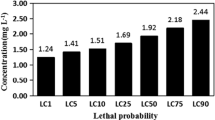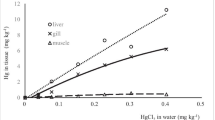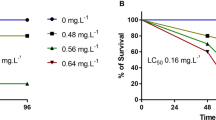Abstract
Ethylmercury (EtHg) has been widely observed in the environment due to anthropogenic contamination and/or environmental ethylation of inorganic mercury. Herein, the acute and sublethal effect of EtHg chloride on Chinese rare minnow (Gobiocypris rarus) as a fish model was studied. EtHg chloride showed an obvious toxicity to 4-month-old Chinese rare minnow (LC50 24.8 µg L−1 (as Hg) at 24 h). Histological analysis revealed that acute EtHg exposure can induce necrosis, telangiectasis and exfoliation of epithelial cells in the gill, as well as edema, vacuoles, and pyknotic nuclei in hepatocytes. Sublethal dose exposure revealed a very high accumulation of EtHg in fish, which is subsequently metabolized to inorganic mercury and eliminated after depuration. A new mercury species, possibly diethylmercury, was also observed as the metabolite of EtHg in rare minnow. The present study provides useful information for assessing the risks of EtHg and understanding its bioaccumulation in aquatic organisms.




Similar content being viewed by others
References
Acosta G, Spisso A, Fernandez LP, Martinez LD, Pacheco PH, Gil RA (2015) Determination of thimerosal in pharmaceutical industry effluents and river waters by HPLC coupled to atomic fluorescence spectrometry through post-column UV-assisted vapor generation. J Pharm Biomed 106:79–84
Boening DW (2000) Ecological effects, transport, and fate of mercury: a general review. Chemosphere 40:1335–1351
Burbacher TM, Shen DD, Liberato N, Grant KS, Cernichiari E, Clarkson T (2005) Comparison of blood and brain mercury levels in infant monkeys exposed to methylmercury or vaccines containing thimerosal. Environ Health Perspect 113:1015–1021
Cai Y, Jaffe R, Jones R (1997) Ethylmercury in the soils and sediments of the Florida Everglades. Environ Sci Technol 31:302–305
Cavoura O, Brombach CC, Cortis R, Davidson CM, Gajdosechova Z, Keenan HE, Krupp EM (2017) Mercury alkylation in freshwater sediments from Scottish canals. Chemosphere 183:27–35
Driscoll CT, Mason RP, Chan HM, Jacob DJ, Pirrone N (2013) Mercury as a global pollutant: sources, pathways, and effects. Environ Sci Technol 47:4967–4983
Drum DA (2009) Are toxic biometals destroying your children’s future? Biometals 22:697–700
Fortmann L, Gay DD, Wirtz K (1978) Ethylmercury: formation in plant tissues and relation to methylmercury formation. US Environmental Protection Agency, Las Vegas
Geier DA, Sykes LK, Geier MR (2007) A review of thimerosal (merthiolate) and its ethylmercury breakdown product: specific historical considerations regarding safety and effectiveness. J Toxicol Environ Health B 10:575–596
Hempel M, Kuballa J, Jantzen E (2000) Discovery of a transalkylation mechanism—identification of ethylmercury at a tetraethyllead-contaminated site using sodiumtetrapropylborate, GC-AED and HPLC-AFS. Fresen J Anal Chem 366:470–475
Hintelmann H, Hempel M, Wilken RD (1995) Observation of unusual organic mercury species in soils and sediments of industrially contaminated sites. Environ Sci Technol 29:1845–1850
Holmes J, Lean D (2006) Factors that influence methylmercury flux rates from wetland sediments. Sci Total Environ 368:306–319
Kodamatani H, Tomiyasu T (2013) Selective determination method for measurement of methylmercury and ethylmercury in soil/sediment samples using high-performance liquid chromatography-chemiluminescence detection coupled with simple extraction technique. J Chromatogr A 1288:155–159
Kodamatani H, Katsuma S, Shigetomi A, Hokazono T, Imura R, Kanzaki R, Tomiyasu T (2018) Behavior of mercury from the fumarolic activity of Mt. Myoko, Japan: production of methylmercury and ethylmercury in forest soil. Environ Earth Sci 77:478
Ma X, Yin YG, Shi JB, Liu JF, Jiang GB (2014) Species-specific isotope dilution-GC-ICP-MS for accurate and precise measurement of methylmercury in water, sediments and biological tissues. Anal Methods 6:164–169
Magos L, Brown AW, Sparrow S, Bailey E, Snowden RT, Skipp WR (1985) The comparative toxicology of ethyl- and methylmercury. Arch Toxicol 57:260–267
Mao YX, Yin YG, Li YB, Liu GL, Feng XB, Jiang GB, Cai Y (2010) Occurrence of monoethylmercury in the Florida Everglades: identification and verification. Environ Pollut 158:3378–3384
PAN Pesticides Database, Chemical toxicity studies on aquatic organisms-Toxicity studies for ethylmercury chloride on fish, http://www.pesticideinfo.org/List_AquireAll.jsp?Rec_Id=PC 36738& Taxa_Group = Fish
Paudyn A, Vanloon JC (1986) Determination of organic forms of mercury and arsenic in water and atmospheric samples by gas chromatography-atomic absorption. Fresen Anal Chem 325:369–376
Seixas TG, Moreira I, Siciliano S, Malm O, Kehrig HA (2014) Differences in methylmercury and inorganic mercury biomagnification in a tropical marine food web. Bull Environ Contam 92:274–278
Siciliano SD, Sangster A, Daughney CJ, Loseto L, Germida JJ, Rencz AN, O’Driscoll NJ, Lean DRS (2003) Are methylmercury concentrations in the wetlands of Kejimkujik National Park, Nova Scotia, Canada, dependent on geology? J Environ Qual 32:2085–2094
Suda I, Takahashi H (1992) Degradation of methyl and ethyl mercury into inorganic mercury by otther reactive oxygen species besides hydroxyl radical. Arch Toxicol 66:34–39
Yamanaka S, Ueda K (1975) High ethylmercury in river fish by man-made pollution. Bull Environ Contam Toxicol 14:409–414
Yin YG, Liu JF, He B, Gao EL, Jiang GB (2007) Photo-induced chemical vapour generation with formic acid: novel interface for high performance liquid chromatography-atomic fluorescence spectrometry hyphenated system and application in speciation of mercury. J Anal At Spectrom 22:822–826
Yin YG, Chen BW, Mao YX, Wang T, Liu JF, Cai Y, Jiang G (2012) Possible alkylation of inorganic Hg (II) by photochemical processes in the environment. Chemosphere 88:8–16
Acknowledgements
This work was supported by the National Natural Science Foundation of China (Grant Nos. 21522705, 21777178), Key Projects for Frontier Sciences of CAS (QYZDB-SSW-DQC018), and the Youth Innovation Promotion Association of CAS (Grant No. 2016037).
Author information
Authors and Affiliations
Corresponding author
Rights and permissions
About this article
Cite this article
Cao, D., He, B. & Yin, Y. Acute and Sublethal Effects of Ethylmercury Chloride on Chinese Rare Minnow (Gobiocypris rarus): Accumulation, Elimination, and Histological Changes. Bull Environ Contam Toxicol 102, 708–713 (2019). https://doi.org/10.1007/s00128-018-2513-3
Received:
Accepted:
Published:
Issue Date:
DOI: https://doi.org/10.1007/s00128-018-2513-3




